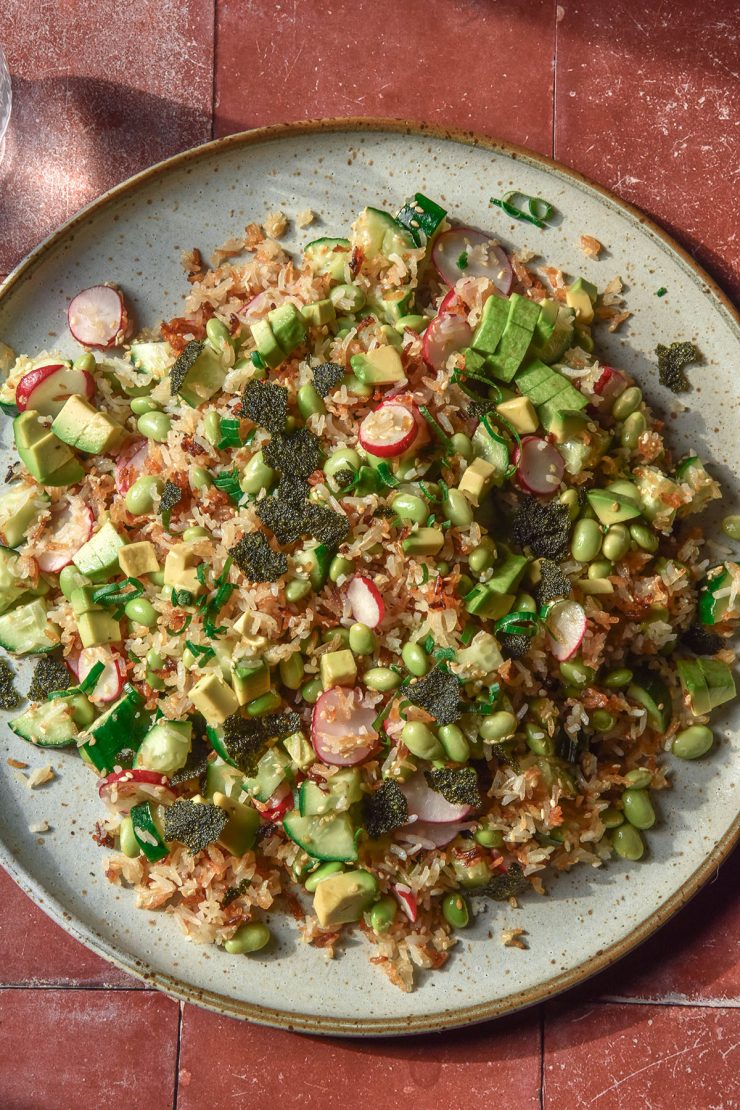
I have had the idea of a sushi salad (or should I say, sushi inspired salad) swirling around in my head for ages now. For whatever reason, I never enjoyed the cold rice element in the salad. A personal preference, I’m sure (I like cold rice in sushi?) but a barrier nonetheless. After making a low FODMAP take on Nam Khao (Laotian crispy rice salad) I had a brain wave: crispy rice sushi salad.
Sushi salad
As the name suggests, this salad is vegan, low FODMAP and nut free. It uses crispy rice as the base of the salad for a chewy and delicious grain option that soaks up the dressing.
I developed this recipe in partnership with Remedy Kombucha and used their small batch Mandarin and Yuzu Kombucha to form part of the dressing base. It is combined with rice wine vinegar, sugar and seasoning, plenty of freshly grated ginger and some wasabi paste. This combination creates a fresh and powerful dressing that beautifully coats the rice.
To finish the salad, we’re adding the classic sushi and sushi-adjacent additions. Edamame beans add vegan protein and are combined with cucumbers and radishes for a fresh crunch. I also add pickled sushi ginger (gari) but this is optional.
Once tossed, the salad is topped with avocado, sesame seeds and spring onion greens.
I like to finish my salad with a good drizzle of toasted sesame oil for a delicious rich sesame flavour. Crispy seaweed crumbled over the top adds a classic sushi flavour and appearance (but again, this is optional).
And that’s it! A flavour packed salad that is healthy and absolutely delicious.

Optional ingredients
There are plenty of different things you can add to the sushi salad. Of course, if you’re not vegetarian you could add some grilled chicken or teriyaki salmon.
I quite like adding some torn up crispy seaweed for crunch or using the strips to eat the salad with my hands.
If you are not vegan and check the labels for any high FODMAP ingredients, you could replace the sesame seeds on top with some furikake.
Another thing I like doing is drizzling the top of my plate of salad with some kewpie mayo. They make a vegan version these days although I am not certain it is low FODMAP.
To amp up the yuzu flavour, you can add some yuzu to the salad dressing.
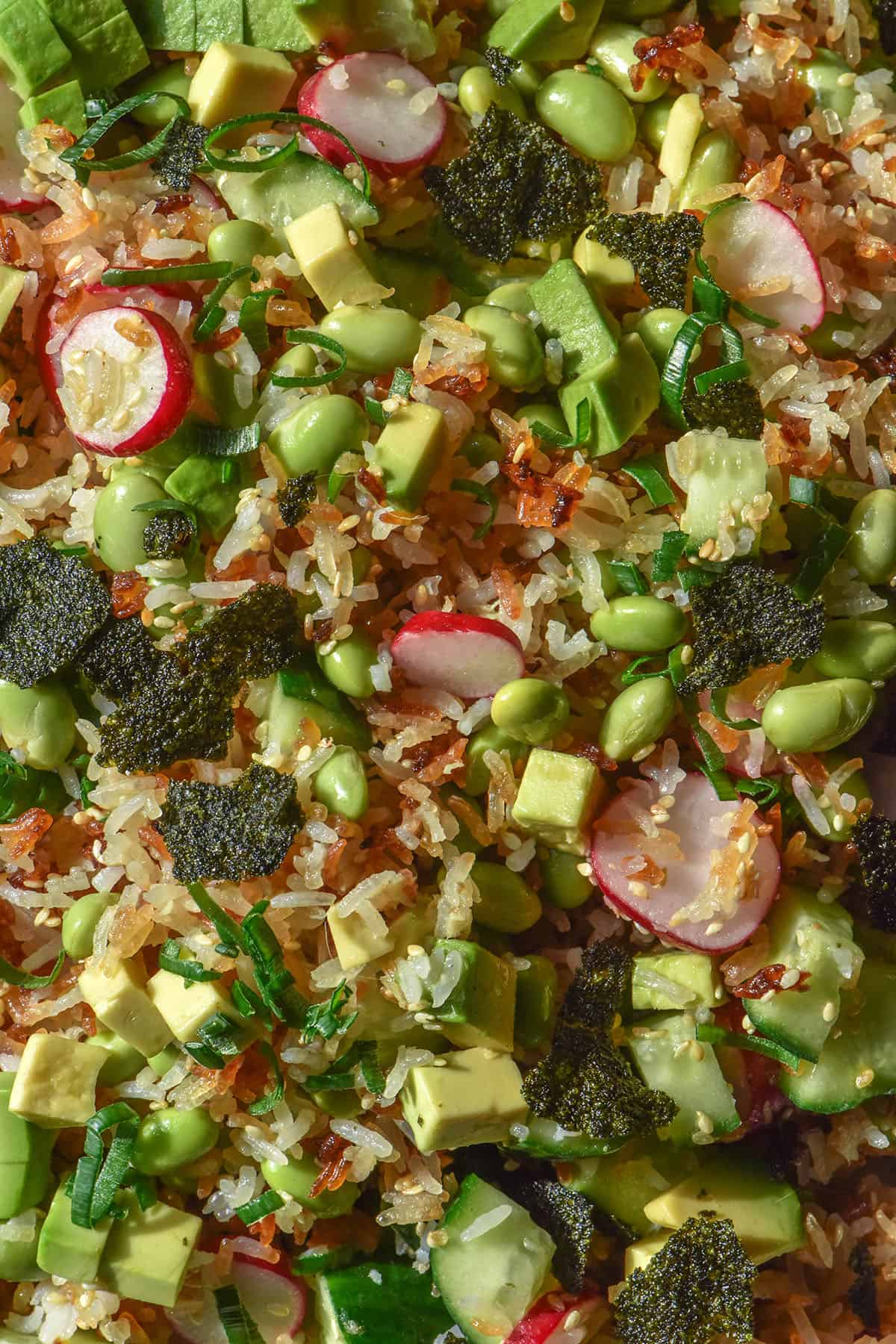
FODMAP notes
These FODMAP thresholds are current as of 2025. They will be periodically updated to ensure the information is current.
Rice is a low FODMAP food and remains low FODMAP in serves of up to 500g.
Edamame beans are low FODMAP 75g serves per person. However, they don’t become moderate for fructan until they exceed 195g serves per person. I generally use 200g in this salad and it serves around 4 as a big lunch.
Lebanese cucumber is low FODMAP in 75g serves. However, it doesn’t become moderate for fructose until it exceeds 97g serves per person.
Radishes are a low FODMAP food and remain low FODMAP in serves of up to 500g.
Spring onion greens are low FODMAP in 75g serves. In serves of 97g or more, they contain moderate amounts of fructose. I have found that I react more to them these, so I don’t use many in this salad.
Rice wine vinegar is low FODMAP and remains low FODMAP in serves of up to 500g.
Avocado is low FODMAP in 60g serves per person. In 80g serves, it contains moderate amounts of perseitol (sort of in the sorbitol family).
Finally, kombucha! Kombucha is low FODMAP in 180ml serves and this recipe uses 80ml.
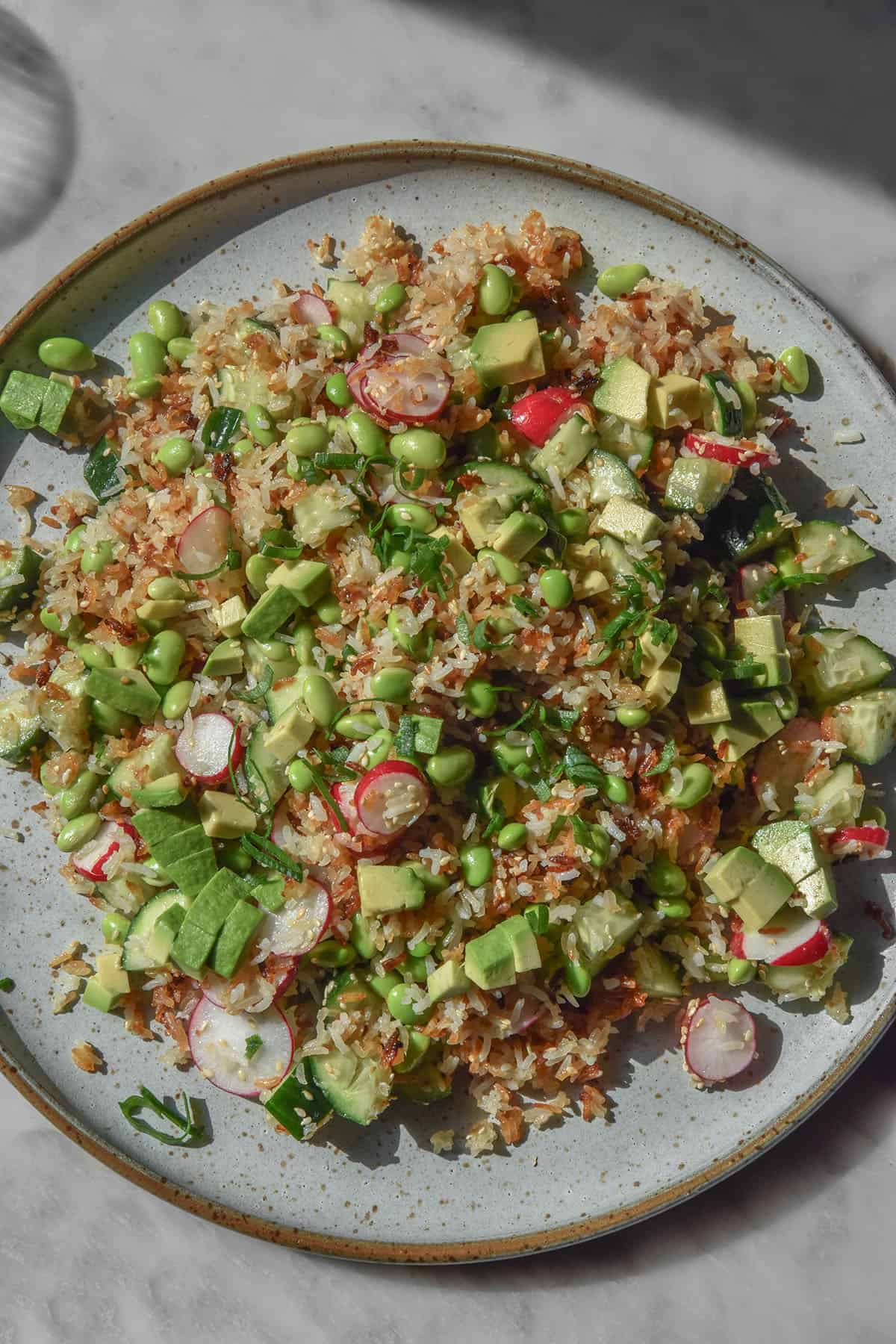
A note on wasabi paste
I only realised when writing up this recipe that wasabi paste has a very small low FODMAP threshold. According to Monash, it is only low FODMAP in 0.8g serves per person. In larger serves, it contains sorbitol. However, FODMAP Everyday says it is low FODMAP in serves of up to 60g. FODMAP Everyday say it is a fructan containing ingredient. I can’t be sure why there is such a big discrepancy here.
I have been using 2 teaspoons in this salad with no issue. However, you may need to assess your own tolerance and see what works for you.
And if you find you do have issues with wasabi paste? Try wasabi powder. You can buy wasabi powder at Asian grocers, online and likely in more bougie food stores. I have not worked with it before so I would suggest adding it to your tastes. When I get my hands on some I will remake this salad and update the post with my tips and recommendations.
By all accounts, store bought wasabi paste is generally horseradish and not wasabi. I haven’t tried this, but you could experiment with adding a little bit of horseradish if that’s easier for you to find.
Another option is simply to add loads of grated ginger. This will bring the flavour and a bit of heat.
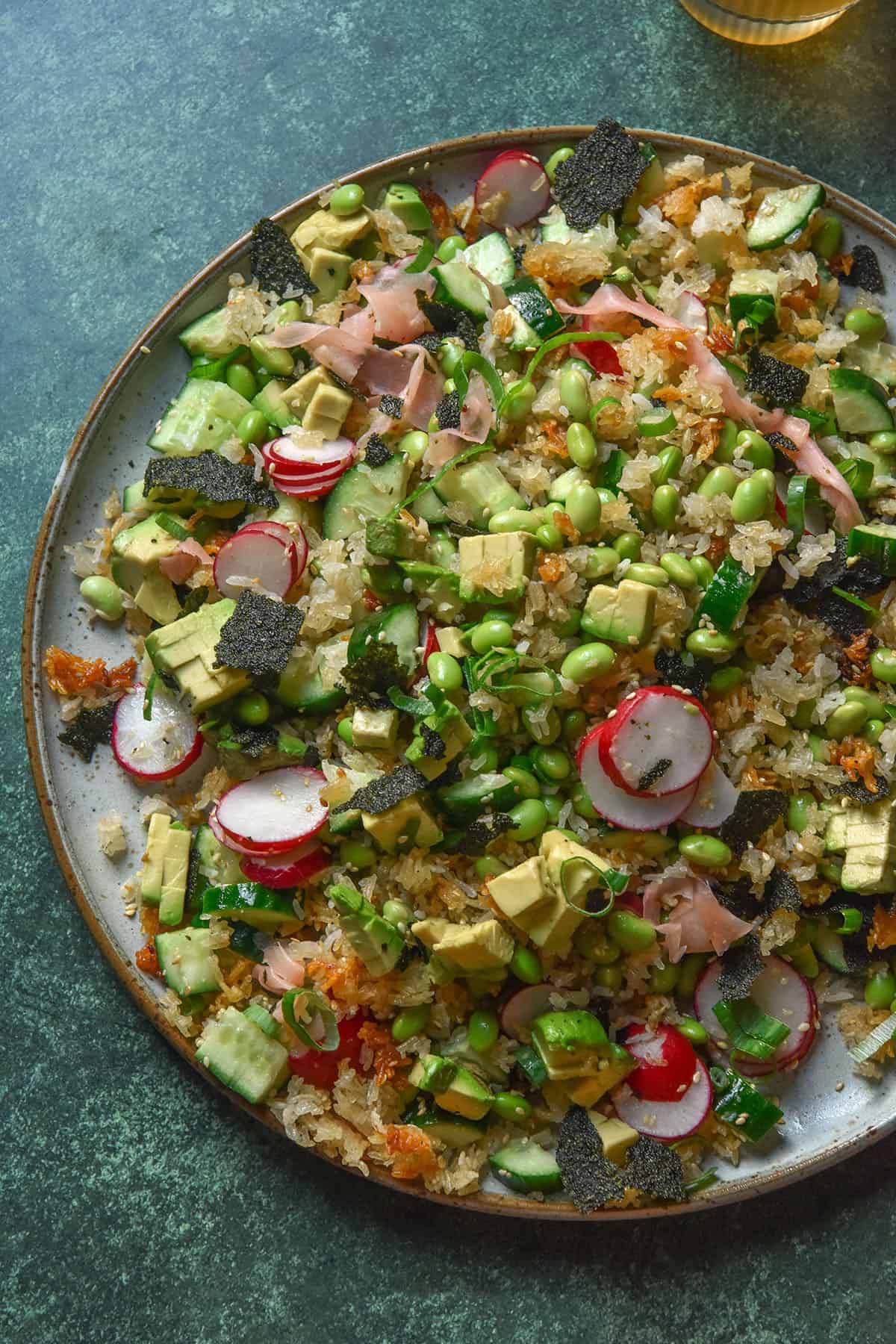
Tips for the crispy rice element of your sushi salad
I don’t currently own an air fryer, but everything I have read suggests it is far easier to make crispy rice in an air fryer. This website here has a guide on making Korean crispy rice in the air fryer. I converted the cups into grams and the recipe uses around 370g cooked rice which is less than we are using. This means you might need to cook the rice in two batches. With that said, it should still be quicker than the oven.
In my testing, I found that placing all the rice on one large tray meant that the oven was far less steamy. This is important because steam is the enemy of crispiness, so we want to minimise that.
I recommend thoroughly rinsing your rice before you cook it. Allowing the water to run clear of starches is a good way of eyeballing it. Less starchy rice is less likely to clump together during the crisping process.
That said, some clumping is good. I love a mix of chewy, lighter pieces of rice vs deeply browned crispy bits of rice.
After 40 minutes of baking, the rice should have shrunk and have some golden brown pieces (notably around the edges). I find this is a good time to turn the oven down, as the edge pieces can burn very quickly.
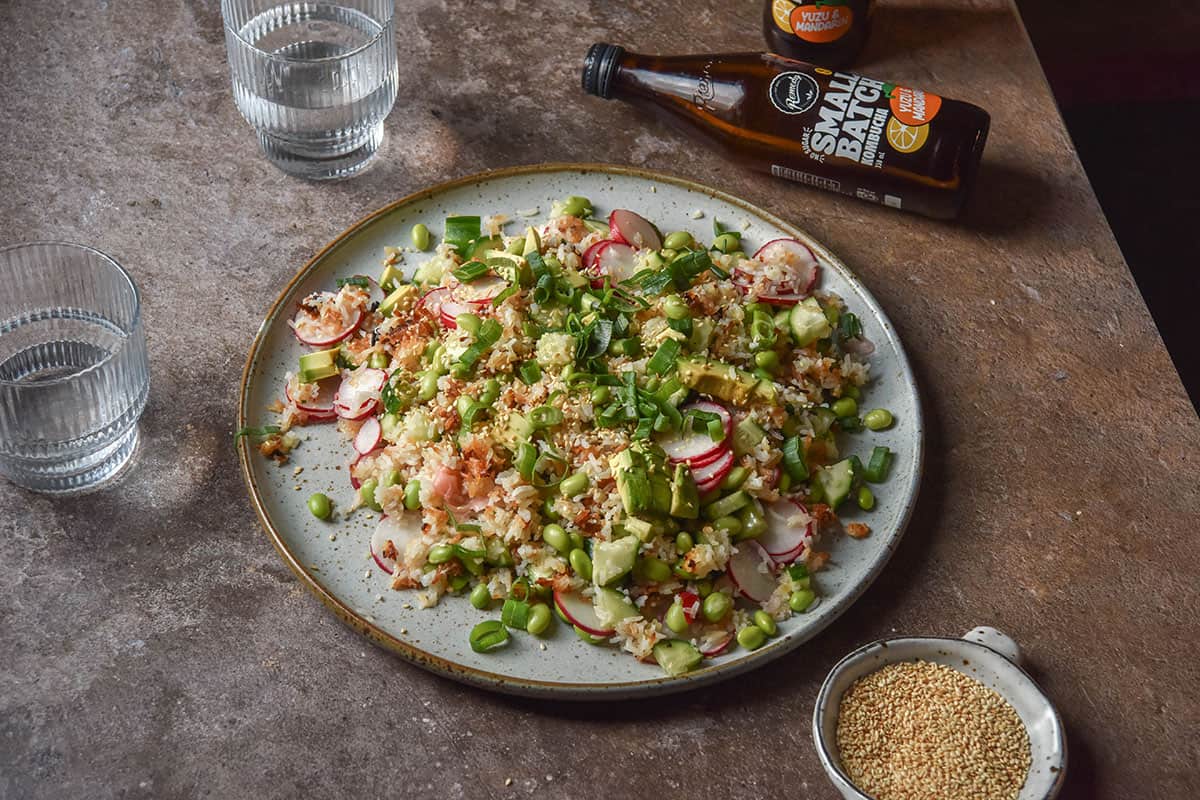
More salad recipes
- Low FODMAP Nam Khao (Laotian crispy rice salad)
- Low FODMAP chopped salad
- Low FODMAP dense bean salad on my paid Substack
- Roasted pumpkin, kale, feta and pomegranate salad
- Low FODMAP salad recipe roundup
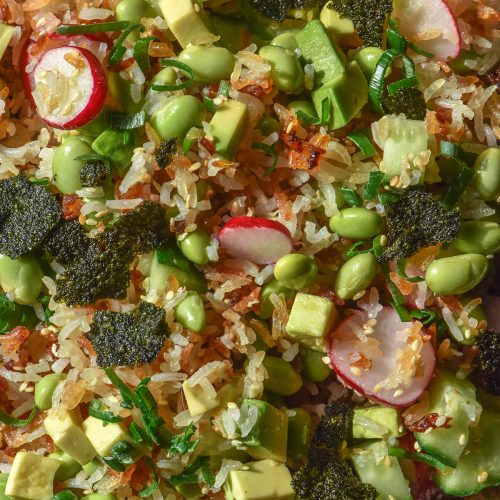
Crispy sushi Salad
Ingredients
For the crispy rice:
- 400 g Jasmin rice, rinsed, cooked and cooled (ideally the day before)
- 40-60 ml (2-3 tablespoons)* toasted sesame oil
- 1 teaspoon white sugar
- 1 teaspoon fine salt
For the dressing:
- 80 ml (1/3 cup)* Remedy mandarin and yuzu Small Batch kombucha
- 60-80 ml (1/4 – 1/3 cup)* white rice vinegar (see notes)
- 4 teaspoons white sugar
- Plenty of freshly grated ginger to your tastes
- 1-2 teaspoons wasabi paste to your tastes (see notes in body of post)
- Seasoning to your tastes
For the salad:
- 150 -200g edamame beans defrosted if frozen (I recommend the frozen ones as opposed to the canned ones)
- 200g Lebanese cucumber chopped
- 1 small bunch of radishes about 150g radish once trimmed finely sliced
- Pickled sushi ginger gari, to your tastes (optional)
To finish:
- ½ – 1 avocado cubed
- 2 tablespoons* toasted sesame seeds
- 3-4 spring onion greens finely chopped (optional)
- 20-40 ml (1-2 tablespoons)* toasted sesame oil
- 2-3 crispy seaweed pieces, crushed (optional)
Instructions
- Cook your rice in salted water ahead of time. Using cooked and cooled rice allows the rice to crisp up more effectively than using freshly cooked rice, which might become mushy.
- Preheat your oven to 230C/446F and line a large, sturdy baking tray.
- Combine the ingredients for the rice flavouring in a large mixing bowl. Pour in the rice and stir or use your hands to coat the rice evenly in the mixture.
- Spread the rice evenly across the baking tray. Bake for 20 minutes, then stir the rice and turn the tray around to encourage even baking. Bake for another 20 minutes and repeat the process of stirring and turning the tray. The rice should be getting brown, so turn the oven down to 200C/400F and bake for an additional 10-20 minutes. The ideal consistency is super crispy and browned with some lighter, chewier bits of rice as well.
- While you’re waiting for the rice, combine all of the dressing ingredients in a large mixing bowl. Taste and adjust according to your preferences, keeping in mind that it will be super zingy and vinegary but this will tone down once it soaks into the rice and other ingredients.
- Once the rice is browned and crispy, pour it straight into the dressing. Stir to coat, then add the remaining ingredients for the salad. Stir to coat everything in the dressing, then decant the salad onto your serving platter.
- To finish, spread the avocado cubes over the top of the salad. Sprinkle over the sesame seeds and spring onion greens. I like to serve with a drizzle of toasted sesame oil for extra flavour and some crushed crispy seaweed for textural interest.
Notes
- The main trick to this salad is figuring out how much vinegar to add. If you are serving the salad immediately, use the lesser quantity of vinegar (or add it to your tastes). If you are intending to make the salad as meal prep, add a bit more vinegar. The rice tends to soak up the vinegar overnight and the salad loses a bit of zing. Adding a bit more vinegar will counteract this.
- In a similar fashion, the more wasabi paste you add, the less vinegar you need. Wasabi creates a bold flavour meaning that less vinegar is necessary. If you don’t add any wasabi, you might need a bit more vinegar and ginger.
- Add the grated ginger liberally! It really rounds out the flavour and will mellow out with all the salad ingredients.
- By all accounts, you can make crispy rice in an air fryer which saves time. I don’t have an air fryer (yet) but this is an option for those who do.
- I found that dividing the rice onto two trays made for a steamier oven than condensing the rice on a single tray. Steam is the enemy of crispiness, which is why I recommend sticking to a single large tray.
- If you happen to have any yuzu juice on hand, you can add a splash to amp up the yuzu flavour.
- If you have any crispy sushi sheets, they also make a delicious addition crumbled over the top.

No Comments